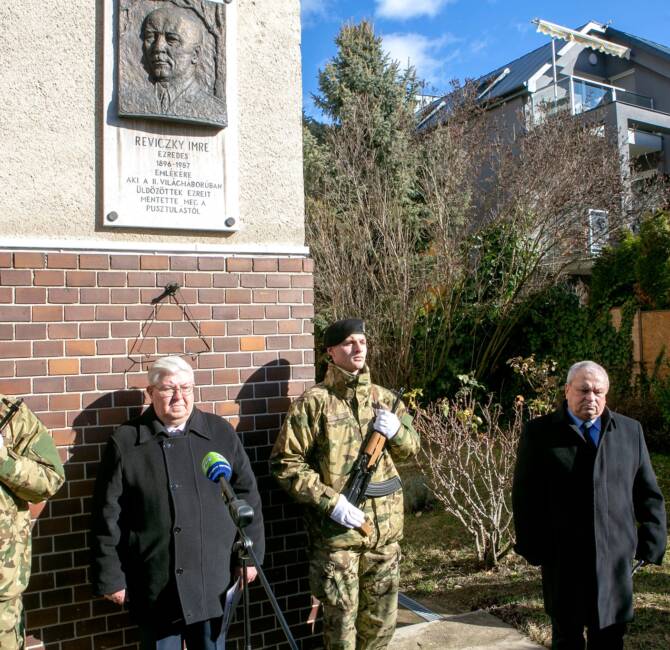This article was published online by the Magyar Nemzet on 8 January 2022.
One hundred years ago, the uprising which broke out on August 28, 1921 in western Hungary, prevented Austria from occupying the Hungarian territories promised to it in the Treaty of Saint-Germain-en-Laye. The opposition of the Rongyos (Ragged) Guard and others led to the Venice treaty and a plebiscite which decided whether Sopron and eight surrounding towns would be part of Austria or Hungary. After the Great War, a mutilated and ransacked Hungary was faced with difficult challenges; Hungary’s isolated foreign policy was further exacerbated by the emergence of the little entente in the wake of the first royal coup, just waiting to attack the maimed country.
Thanks to the Paris Peace dictates, on September 10, 1919, the Social Democratic Austria received the western parts of Hungary: Moson, Sopron and Vas countries, including the city of Sopron and its surroundings. This would prevent the establishment of a Czechoslovakian-Southern Slavic corridor to the west of the Balaton. The other, more obvious intention of the winners was to reward the losing Austria with the Burgenland (Orvidek) for saying no to the Anschluss.
Mihály Francia Kiss, Iván Héjjas, Pál Prónay. They were all god-fearing, patriotic Hungarians who fought the Great War with honor, won many military awards through their bravery and perseverance; they also experienced the mournful downfall and the horrors of the Red Terror. Understandably, they opposed all this and became the leaders of the “White Terror”. The pre-1989 historiography – and of course today’s “advanced” liberal historians – only accounts for their anti-Bolshevik actions in 1919 in a distorted way. Meanwhile, they conceal or at least minimize the former 13th Jászkun Hussar
officer, Pál Prónay de Tótpróna et Blatnicza’s role in leading the uprising in Western Hungary and achieving the referendum that resulted in Sopron and its surrounding villages remaining in Hungary.
Following Trianon, many believed that it could not get worse after the defeat in war, Károlyi’s pacifist disagreements, the bloody 133 days of the Hungarian Soviet Republic, the total humiliation and looting that accompanied the Romanian, Serbian, and Czechoslovakian occupations, and the suicidal peace treaty. Then, 1921 brought fresh challenges to the economically, socially, and militarily mutilated, politically isolated Kingdom of Hungary led by Vitéz Miklós Horthy de Nagybánya.
According to the recollections of the Hungarian Foreign Minister at the time, Count Miklós Bánffy de Losoncz, “the peace treaty ordered that the final borders come into force immediately after its ratification. The Serbs must evacuate the part of Baranya left to us, and we must hand Burgenland over to Austria. This handover was extremely painful for us. The other parts of our country that Trianon allocated to our neighbors, were already occupied since the end of the war; the Hungarian officials there were expelled by the invaders after the armistice. The situation with Burgenland was different though. There we were still in charge. The Hungarian government itself had to take care of the handover and make sure it happened. It was as if our arm were chopped off, and then we were expected to hand over that arm on a silver platter. This painfulness was even more poignant since we were handing over Sopron and its surroundings not to a country that won the war, but Austria. There was a sort of terrible humiliation and hellish mockery in this. The Hungarians fought for centuries to defend their homeland against Austria. And now, as the entente breaks apart the Austrian empire, they ask us to hand over land that was always ours. When Austria was just as defeated as we were. Moreover, our relationship with Austria plunged us into war. A war that no one in Hungary actually wanted. […] And now they demand that we hand over to Vienna lands that were ours since the Árpád era. A truly perverse thought behind this demand.”
Hussar Captain Viktor Maderspach who fled southern Transylvania wrote that “official soldiers do not become irredentists” and “it became clear in August 1921, that the Hungarian government lost the diplomatic campaign it had been waging to save Western Hungary. The time has come for social organizations to take action to save the irreplaceable territory of our country in this cultural respect.”
The Hungarian government was literally dancing on the edge as it could not support the uprising, only in secret. The weapons came from Austria as the Rongyos Guard took them from the Fürstenfeld arms warehouse in the summer of the previous year; the arsenal, hidden in a farm around Kecskemét, was sent to Western Hungary in August 1921. The Nyugat-magyarországi Liga (League of Western Hungary), Ébredő Magyarok Egyesülete (Association of Awakening Hungarians), Kettőskereszt Vérszövetség (Cross Blood Association) and other irredentist organizations were banned due to foreign pressure. But they started recruiting and the Rongyos Guard mobilized along with the Sopron Youth Circle which sent out this “uprising summons”: “My dear friend! The homeland is calling. There is no obligation, but if you can, come voluntarily and immediately to Sopron.”
On August 20, 1921, a mass demonstration took place in Sopron because the brave “póncikterek” (wine-merchants in the Sorpon area) did not want Sopron to be the capital of the Austrian Burgenland under the name Ödenburg. According to Ernő Träger’s recollection, “hundreds of fists rose high and voices cursing Austria erupted from the crowd. The Entente commissioners looked around, shaken and touched by the loyalty and attachment to Hungary.” Sopron had to be handed over on August 29th; the Hungarian offices were emptied, and the National Army withdrew. The Hungarian side of the handover was managed by Count Antal Sigray, government commissioner; public order was supervised by Major Gyula Ostenburg-Moravek II. and his gendarmerie.
“Sopron is a thousand-year-old Hungarian treasure”, “Sopron belongs to the people of Sopron” – said the citizens of Sopron, justifiably. They turned to Lieutenant colonel Pál Prónay, commander of the 1st battalion, who said “several Sopron citizens, with mayor Mihály Thurner at the helm, found me in Budapest, in the Nádor barracks, as their final hope. Lord help us! Western Hungary must be handed over – this is a closed deal – but do something, at the very least we could save Sopron […] Upon hearing the aforementioned, I immediately took the necessary measures in the battalion itself and with the associated irredentist organizations.”
On August 28th, the Austrian gendarmes crossed the historical border, but they were stopped at Ágfalva by the Rongyos Guard’s Mihály Francia Kiss, infantry sergeant, Károly Kaszala of Oszlány, air force sergeant who won 9 flight battles in the Great War, and Hussar Viktor Maderspach, feared by the Romanians. Major Ostenburg-Moravek’s gendarmes marched into Sopron to prevent the Austrian takeover; the battalion commander announced to
commissioner Sigray that they won’t give up the city, “I won’t leave Sopron alive!”
The rebels also recaptured Ágfalva and Brennbergbánya, and various contingents played important roles in these battles. Among these were the Rongyos Guard along with patriots and anti-Bolsheviks as well as: officers, non-commissioned officers, and soldiers from the Great War; members of the former Szekler Division; peasant from the areas surrounding Keckemét, Kunszentmiklós, and Gödöllő; college students from Sopron, farmers from Magyaróvár, students from the Budapest technical university, refugee academics from Banská Štiavnica (Selmecbánya), highschoolers from Kecskemét and Győr, and Albanian and Bosnian insurgents.
In addition to Sopron, Lieutenant Iván Héjjas’ men tore up the railways in multiple places to cut off Austrian supply. The two-months long uprising broke out in the Lajta and Pinka regions with five “rebel armies” in action and the Hungarian rail workers and scouts supporting them all along. In the battles around Sopron, 24 rebels died and one passed away due to illness. Among the heroic dead were Ferenc Pehm and József Pehm, relatives of cardinal József Mindszenty. Their memories are also preserved by Gyula Somogyváry’s És mégis élünk (And still, we live) novel.
The guerrilla insurgents – who were called bandits by the Austrians while the Western press wrote about civilians, insurgents, and patriots – formed the Lajtabánság (Banate of Leitha) on October 4, 1920 after stopping the Austrians in several clashes (at Ágfalva, Pinkafő, Alhó, Burgóhegy). They elected Pál Prónay as Ban. The ephemeral state, with an area of 4,000 kilometers and a population of 200,000 levied customs duties and issued a stamp; its mere existence supported the Hungarian government’s goals as after the second unsuccessful royal coup, Hungary and Austria sat down to negotiate in Venice. The Hungarians agreed to evacuate the insurgents from the territories and the Austrians agreed to a referendum on Sopron where Sopron should belong.
On December 14-16 1921, Sopron and 8 of its surrounding villages – Ágfalva, Balf, Fertőboz, Fertőrákos, Harka, Kópháza, Nagycenk and Sopronbánfalva – decided that they did not want Austrian rule and chose to stay under the Hungarian Holy Crown. Thus, Sopron rightly deserved the “Civitas fidelissima” motto. This was written in the 1922 XXIX. Legislation. The preamble states that the population of the Sopron referendum area, tried in times of hardship proved their unwavering loyalty to Hungary in the referendum. This
manifestation of faithful affection in all the sons of the Hungarian homeland confirmed the hope for a happier future and the eternal trump of divine truth.
Sopron did not become Ödenburg. To quote the former regent Miklós Horthy, “75 percent of the population sided with Hungary. Maybe even more importantly, Hungary is seeking revision through peaceful means, as well as the fact that the first gap has opened in the prison walls erected around Hungary.”
Zoltán Babucs
Hungarian Institute of Research




